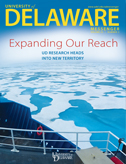
Changing the color of light
OUR FACULTY | UD researchers have received a $1 million grant from the W.M. Keck Foundation to explore a new idea that could improve solar cells, medical imaging and even cancer treatments. Simply put, they want to change the color of light, turning low-energy colors (like red) into higher-energy colors (like blue or green).
Changing the color of light would give solar technology a considerable boost. A traditional solar cell can only absorb light with energy above a certain threshold. Infrared light passes right through, its energy untapped. However, if that low-energy light could be transformed, a solar cell could absorb much more of the sun’s clean, free, abundant energy. The team predicts that their novel approach could increase the efficiency of commercial solar cells by 25 to 30 percent.
The research team, based in the College of Engineering, is led by Matthew Doty, associate professor of materials science and engineering and associate director of UD’s Nanofabrication Facility.
“You can’t simply turn a red photon into a blue one,” Doty explains. “But you can combine the energy from two or more red photons to make one blue photon.”
While this process of “photon upconversion” isn’t new, he adds, the UD team’s approach is.
They want to design a new kind of semiconductor nanostructure that will act like a ratchet, absorbing two red photons, one after the other, to push an electron into an excited state when it can emit a single high-energy (blue) photon.
“Think of the electrons in this structure as if they were at a water park,” Doty says. “The first red photon has only enough energy to push an electron half-way up the ladder of the water slide. The second red photon pushes it the rest of the way up. Then the electron goes down the slide, releasing all of that energy in a single process, with the emission of the blue photon. The trick is to make sure the electron doesn’t slip down the ladder before the second photon arrives. The semiconductor ratchet structure is how we trap the electron in the middle of the ladder until the second photon arrives to push it the rest of the way up.”
The UD team will develop new semiconductor structures containing multiple layers of different materials, such as aluminum arsenide and gallium bismuth arsenide, each only a few nanometers thick. This “tailored landscape” will control the flow of electrons into states with varying potential energy, turning once-wasted photons into useful energy.
The UD team has shown theoretically that their semiconductors could reach an upconversion efficiency of 86 percent, which would be a vast improvement over the 36 percent efficiency demonstrated by today’s best materials. What’s more, Doty says, the amount of light absorbed and energy emitted by the structures could be customized for a variety of applications, from lightbulbs to laser-guided surgery.Doty’s co-investigators include Joshua Zide, Diane Sellers and Chris Kloxin, all in the Department of Materials Science and Engineering; and Emily Day and John Slater, both in the Department of Biomedical Engineering.
Article by Tracey Bryant


